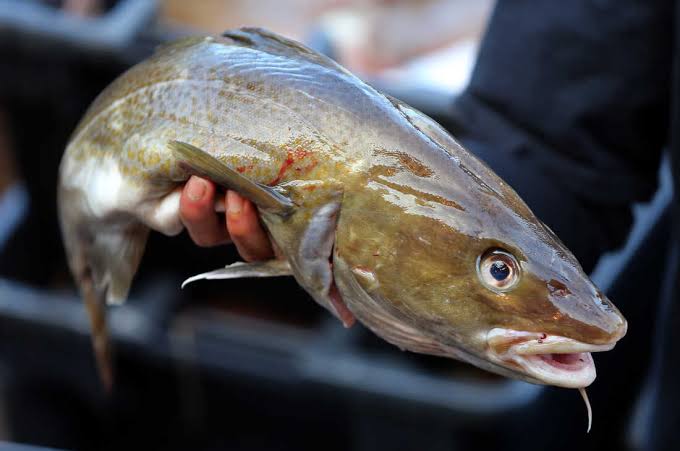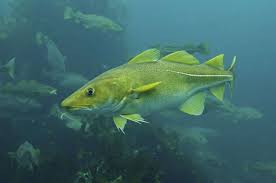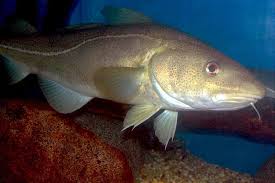Cod, a remarkable fish found in cold waters, has been a staple in human diets for centuries. Its significance extends beyond just culinary delight; it plays a crucial role in the ecosystem and has a fascinating history intertwined with human civilization.
This creature, scientifically known as Gadus morhua, boasts a distinctive appearance with its elongated body and prominent chin barbel. Its silvery skin and mild flavor make it a favorite among seafood enthusiasts worldwide. Fishermen often venture into the depths of the Atlantic and other chilly waters to capture this prized species.
In the culinary realm, cod stands out for its versatility. From classic fish and chips to sophisticated seafood dishes, its white, flaky flesh adapts well to various cooking methods. Baked, grilled, or fried, cod remains a go-to choice for those seeking a delectable and nutritious meal.
Beyond its culinary appeal, cod holds ecological importance. As a keystone species, it influences the balance of marine ecosystems. Its role in regulating prey populations helps maintain biodiversity and a healthy ocean environment. Moreover, cod has been a key player in the fishing industry, contributing significantly to economies around the world.
The history of cod fishing intertwines with the expansion of maritime trade and exploration. European explorers, seeking new routes and resources, discovered vast cod stocks in the North Atlantic. This discovery fueled a booming industry, with cod becoming a vital commodity for trade and sustenance.
However, the success of cod fishing has not been without challenges. Overfishing and mismanagement have led to declines in cod populations, raising concerns about the sustainability of this industry. Conservation efforts and fisheries management now play a critical role in ensuring the survival of cod stocks and maintaining a delicate ecological balance.
In addition, cod is not just a fish on our plates; it is a symbol of human history, culinary excellence, and ecological interconnectedness. As we savor its delicate taste, let us also reflect on the responsibility we bear in preserving this species for future generations to enjoy.
As we navigate the complexities of sustaining cod populations, collaboration between governments, scientists, and the fishing industry becomes imperative. Sustainable fishing practices, such as catch limits and seasonal closures, aim to protect the delicate balance of marine ecosystems while ensuring a steady supply of cod for consumers.
The journey of cod from ocean to plate involves intricate processes. Fishing vessels equipped with advanced technology set out to sea, guided by knowledge passed down through generations. Once caught, the fish undergoes meticulous handling and processing to maintain its quality and freshness.
In recent years, consumer awareness of sustainable seafood has grown, prompting a shift in market dynamics. Certifications like the Marine Stewardship Council (MSC) ensure that the cod on your plate comes from fisheries committed to responsible practices. This shift reflects a broader societal commitment to environmental consciousness and the preservation of marine life.
Moreover, the nutritional benefits of cod contribute to its popularity. Rich in protein, low in fat, and a good source of vitamins and minerals, cod aligns with the health-conscious preferences of many. It serves as an excellent choice for those seeking a wholesome and nutritious diet.
Despite the challenges faced by cod fisheries, ongoing research and innovation offer hope for the future. Scientists explore ways to enhance aquaculture practices, providing an alternative to wild-caught cod. This approach could potentially alleviate pressure on natural stocks and offer a sustainable solution to meet the global demand for this beloved fish.
However, cod transcends its role as a mere seafood option; it embodies a delicate balance between human consumption and environmental stewardship. As we savor the taste of cod, let us remain mindful of the journey it undertakes and the collective responsibility we bear in preserving not only a culinary tradition but also the health of our oceans.
Read Also: The Benefits of Crop Dusting
Appearance and Features of the Cod

The cod, scientifically known as Gadus morhua, boasts distinct physical characteristics that set it apart in the underwater realm. Its elongated body, typically ranging from olive to brownish-green, adapts well to the cold waters it inhabits. The lateral line, a sensory organ running along its side, aids in detecting vibrations and movements in the surrounding water.
One notable feature is the cod’s prominent chin barbel, a whisker-like projection extending from its lower jaw. This sensory organ serves a crucial function in locating food on the ocean floor. The fish’s relatively small scales contribute to its sleek appearance, providing minimal resistance as it maneuvers through its aquatic environment.
The coloration of cod varies, adapting to its surroundings for camouflage. While the upper portion tends to be darker, the belly is usually lighter, aiding in the fish’s ability to blend in whether it’s swimming in open water or resting on the ocean floor.
Cod’s fins play a role in its movement and stability. The pectoral fins, located on each side, help with steering, while the dorsal fin along its back provides balance. The anal and pelvic fins contribute to stability, allowing the cod to maintain control as it navigates the depths.
In essence, the appearance and features of cod reflect a well-adapted species to its cold-water habitat. Its streamlined body, sensory adaptations, and subtle coloration underscore the evolutionary success of this fish in the intricate dance of life beneath the waves.
Health and Lifespan of Cod Fish
Cod, a fish widely consumed for its culinary appeal, also offers health benefits and possesses certain characteristics related to its lifespan. When included in a balanced diet, cod can contribute positively to overall well-being.
From a nutritional standpoint, cod is a low-fat protein source rich in essential nutrients. It provides a good dose of high-quality protein, essential amino acids, and various vitamins and minerals. Notably, it is a good source of omega-3 fatty acids, which are associated with heart health and various other benefits, including cognitive function.
In terms of potential health concerns, one consideration is the mercury content in certain fish, including cod. While cod generally has lower mercury levels compared to some other seafood, pregnant individuals and young children are often advised to moderate their consumption to minimize mercury exposure.
The lifespan of cod in the wild can vary based on environmental factors and fishing pressures. Typically, cod can live up to several decades. However, factors such as overfishing and habitat changes can impact their population dynamics and longevity. Sustainable fishing practices and conservation efforts aim to maintain healthy cod populations and ensure their continued presence in marine ecosystems.
Understanding the balance between enjoying cod as part of a nutritious diet and preserving its role in the ecosystem is crucial. By making informed choices about sourcing and consumption, individuals can appreciate the health benefits of cod while contributing to the sustainability of this remarkable fish species.
Nutrition and Feeding Mode of Cod
Cod, a popular seafood choice, offers a range of essential nutrients, making it a valuable addition to a balanced diet. Its nutritional profile includes:
1. Protein: Cod is a rich source of high-quality protein, essential for the body’s growth, repair, and maintenance of tissues.
2. Omega-3 Fatty Acids: Cod contains omega-3 fatty acids, particularly eicosapentaenoic acid (EPA) and docosahexaenoic acid (DHA). These fatty acids are known for their cardiovascular benefits and positive effects on brain health.
3. Vitamins: Cod is a good source of various vitamins, including B vitamins such as B12, which is crucial for nerve function and the formation of red blood cells.
4. Minerals: It provides essential minerals like phosphorus, selenium, and iodine. Phosphorus is vital for bone health, selenium acts as an antioxidant, and iodine is essential for thyroid function.
As for the feeding mode of cod, it is primarily a carnivorous species. In its natural habitat, cod preys on smaller fish, crustaceans, and other marine organisms. The barbel, a sensory organ on its lower jaw, aids in locating food on the ocean floor. This feeding behavior is integral to the cod’s role in marine ecosystems, helping regulate prey populations and contributing to the overall balance of the underwater environment.
Understanding both the nutritional value and the ecological role of cod provides a holistic perspective on its significance, both in terms of human consumption and its place in the intricate web of marine life.
Uses of the Cod Fish

Cod serves a multitude of uses, extending beyond its role as a delectable seafood option. Here are some key applications:
1. Culinary Delight: One of the primary uses of cod is its incorporation into a wide array of culinary dishes. Whether baked, grilled, fried, or included in stews, cod’s mild flavor and flaky texture make it a versatile and cherished ingredient in various cuisines worldwide.
2. Economic Importance: Cod fishing has been a cornerstone of the fishing industry for centuries. It has played a pivotal role in the economies of many coastal regions, providing livelihoods for fishermen, supporting processing industries, and contributing to international trade.
3. Health Benefits: The nutritional composition of cod, rich in protein, omega-3 fatty acids, and essential vitamins and minerals, makes it a valuable component of a healthy diet. Consuming cod can contribute to heart health, brain function, and overall well-being.
4. Cultural Significance: Cod holds cultural importance in many societies with a strong maritime history. It has become a symbol of tradition, passed down through generations in the form of recipes, stories, and rituals.
5. Aquaculture: In addition to wild capture, cod is increasingly being cultivated through aquaculture practices. This allows for a controlled and sustainable supply of cod, addressing concerns related to overfishing and ecosystem impact.
6. Ecosystem Regulation: In its natural habitat, cod plays a crucial role in marine ecosystems by regulating prey populations. This helps maintain a balance among different species, contributing to the overall health and biodiversity of the ocean environment.
Understanding these diverse uses emphasizes the significance of cod not only in the culinary world but also in the broader contexts of economy, health, culture, and ecological balance.
Read Also: Growing and Care Guide of Cotton Plants
How to Grow and Care for the Cod Fish

Growing and caring for cod involves a deep understanding of its natural habitat and the careful implementation of aquaculture practices. Here are key considerations:
1. Aquaculture Systems:
Hatcheries: Begin with obtaining cod juveniles from reputable hatcheries. Hatchery-raised juveniles provide a controlled starting point for aquaculture.
Aquaculture Tanks or Ponds: Set up suitable tanks or ponds for growing cod. Ensure adequate space and proper water quality management.
2. Water Quality:
Temperature: Cod thrives in cold waters, so maintaining a suitable temperature range is crucial for their well-being.
Salinity: Cod prefers marine environments, so ensure the salinity levels mimic those found in their natural habitat.
3. Feeding:
Balanced Diet: Provide a nutritionally balanced diet that includes fishmeal, fish oil, and other essential nutrients. Mimic the natural diet of cod to promote healthy growth.
Feeding Schedule: Establish a regular feeding schedule to ensure the cod receives adequate nutrition.
4. Health Monitoring:
Disease Prevention: Implement disease prevention measures, including regular health checks, vaccination if applicable, and maintaining optimal water quality to reduce stress and susceptibility to diseases.
Monitoring Behavior: Regularly observe the behavior of the cod to detect any signs of distress or health issues.
5. Harvesting:
Size Considerations: Decide on the optimal size for harvesting based on market preferences and industry standards.
Humane Harvesting Practices: Employ humane harvesting methods to minimize stress on the fish and maintain product quality.
6. Sustainability Practices:
Stocking Density: Avoid overcrowding to prevent stress and disease outbreaks. Adhere to recommended stocking densities for optimal growth.
Environmental Impact: Implement practices that minimize environmental impact, such as responsible waste management and avoidance of overuse of antibiotics.
7. Regulatory Compliance:
Permits and Regulations: Ensure compliance with local and national regulations governing aquaculture. Obtain necessary permits and adhere to industry standards.
8. Continuous Learning:
Stay Informed: Keep abreast of advancements in aquaculture practices, research, and technology to continuously improve your cod farming operation.
Growing and caring for cod in an aquaculture setting requires dedication, knowledge, and a commitment to sustainable practices. Regular monitoring, attention to water quality, and responsible management contribute to the success of cod cultivation.
Economic Benefits of Cod Fish
The cultivation and harvesting of cod contribute significantly to various economic sectors, providing a range of economic benefits:
1. Employment Opportunities: Cod fishing and aquaculture operations create jobs for a diverse workforce, including fishermen, aquaculturists, processing plant workers, and support staff.
2. Fisheries Industry: The cod fisheries industry is a key player in the global seafood market, contributing to international trade and economic exchange between countries with access to cod-rich waters and those with high consumer demand.
3. Export Revenue: Cod, being a globally traded commodity, generates substantial export revenue for countries with well-established fishing and processing industries. This revenue contributes to the overall economic stability and growth.
4. Local Economies: Coastal communities often depend on cod fisheries for their economic livelihood. Income generated from fishing activities circulates within these local economies, supporting small businesses and contributing to community development.
5. Value-Added Products: Processing cod into value-added products such as fillets, fish cakes, and fish oil adds economic value. These processed goods contribute to a diversified market, catering to different consumer preferences and increasing overall revenue.
6. Tourism: Areas known for their cod fisheries attract tourists interested in experiencing local fishing traditions and enjoying fresh seafood. This tourism contributes to the local economy through hospitality services, restaurants, and related businesses.
7. Innovation and Technology: The cod industry drives innovation and technological advancements in fisheries management, aquaculture practices, and processing methods. This not only enhances efficiency but also stimulates economic growth in related industries.
8. Supply Chain Impact: The cod supply chain involves various stages, from fishing or aquaculture to processing, transportation, and retail. Each stage creates economic activity and supports jobs in logistics, transportation, and marketing.
9. Economic Resilience: Diversification of economic activities, including cod fisheries, enhances the resilience of communities. Dependence on a variety of industries helps buffer against economic downturns in any one sector.
10. Research and Development: Investment in research and development within the cod industry contributes to increased productivity, sustainability, and competitiveness. This, in turn, has positive economic implications for the industry as a whole.
In summary, the economic benefits of cod extend far beyond the plate. They encompass employment, trade, tourism, and technological advancements, playing a vital role in the economic fabric of both local communities and the broader global market.
Read Also: Cod Liver Oil Capsules: All You Need to Know About
